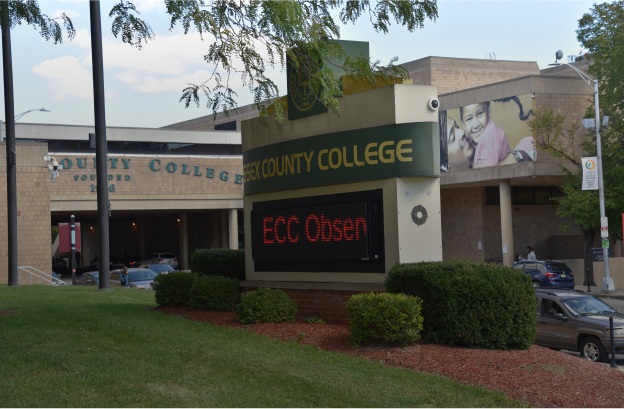Trump cuts would devastate community colleges, undermining lower-income students striving to better their lives
Attacks on Harvard and other Ivy League schools are getting all the attention, but they serve a tiny fraction of the number of students who attend two-year colleges facing dire threats
by Lane Glenn

MassBay Community College students commemorate their graduation in 2018 with a selfie. (MassBay Community College Facebook photo)
FOR THE PAST few months, America’s most prestigious universities have been under attack by a president intent on chastening “woke elites” and flexing his political muscle to show that not even the world’s most esteemed institutions of higher learning are beyond his control.
But while public attention has been focused on Ivy-leaguers like Harvard, Columbia, and the University of Pennsylvania striking deals or filing lawsuits to protect the billions of dollars in federal funding and other public subsidies they receive, another, potentially more dire threat has received much less coverage. It’s a threat with far more sweeping consequences for American higher education and the preparation of the nation’s future workforce.
Congress is considering dramatic changes to federal financial aid that would disproportionately harm community college students, and President Trump has presented a budget for next year that would eliminate nearly every form of federal support for the nation’s most disadvantaged students and institutions.
In a surprise move during Congress’s budget reconciliation process, the House Education and Workforce Committee has recommended major changes to the federal Pell Grant program, which awards around $30 billion annually to more than six million low-income students, while at the same time President Trump has released his proposed budget for fiscal year 2026, which would eliminate TRIO programs aiding first-generation college students, federal Work-Study, and other programs that support college access and success.
Taken together, if enacted, the budget moves would wreak havoc on campuses everywhere, but especially at the nation’s 1,100 community colleges, including 15 here in Massachusetts, which enroll a third of America’s undergraduates, including the poorest, most underserved and vulnerable students in all of higher education.
The Pell Grant: A Pathway to College for Millions
For more than half a century, the Pell Grant Program has provided assistance to students with exceptional financial need, offering them a more affordable pathway to a college degree. While the grant originally paid for nearly all the cost of attending college, including tuition and living expenses, over the years it has not kept up with inflation. Still, it provides up to $7,400 a year per student, about 25 percent of the cost of attending a public university, and half the cost of enrolling at a community college.
Right now, the Pell Grant guidelines define a full-time student as someone enrolled in 12 or more credits. Students can take any number of credits each semester they are enrolled and can qualify for a prorated amount of Pell Grant support based on their courseload.
For example, a low-income student taking twelve credits would qualify for the full $7,400 award, while the same student taking three credits would only qualify for 25 percent, or $1,850, of the that amount.
The changes to the Pell Grant recommended by the House committee would make it harder to qualify for support by redefining full-time enrollment as at least 15 credits and eliminating funding for students enrolled less than halftime, or 7.5 credits.
Students attending four-year universities would barely notice the difference: Nearly 90 percent of them are enrolled full-time and would not be affected by the changes.
At community colleges though, where students are older and often balancing classes with jobs and families, two-thirds of them are enrolled part-time, and the proposed changes to the Pell Grant would have an immediate, devastating effect on community college student enrollment nationwide.
At Northern Essex Community College, nearly half of our students are currently eligible for Pell Grants. This semester, 78 percent are enrolled part-time. They take an average of just over 7.5 credits each semester, though the most common number of credits taken is only 6.
If the proposed Pell Grant changes were implemented, they would impact nearly 3,000 students at NECC, eliminating more than $5 million in financial aid, and likely cutting enrollment by a third or more.
Across all fifteen community colleges in Massachusetts, the changes would affect tens of thousands of students, slashing over $80 million in support and decimating enrollment at the state’s community colleges.
To add injury to injury, the state’s free community college programs, MassReconnect and MassEducate, are “last dollar in” programs that rely on federal Pell Grants.
If Massachusetts had to cover the lost $80 million, especially facing an increasingly bleak budget year ahead, those programs, which were designed to meet the Commonwealth’s future workforce needs, might not be able to continue, and the state’s anticipated college-educated worker shortage would get even worse.
Student Support Services Endangered
While the House committee’s Pell Grant changes would likely result in millions of students dropping out of community colleges because of lost financial aid, the president’s proposed $4 billion budget reductions to the federal TRIO, GEAR UP, Work Study, Child Care and other student support programs would endanger the prospects of those who still managed to enroll.
All of the cuts would be harmful, especially to community college students, but the most significant reductions are to TRIO, which is actually a collection of eight different programs, including Upward Bound, Talent Search, and Student Support Services, all designed to support low-income students, those who are the first in their families to attend college, and students with disabilities.
Altogether, there are more than 3,500 TRIO projects serving nearly 900,000 students across the country for just under $2 billion annually. While outcomes may vary by project, collectively research has shown that TRIO programs have a significant positive impact on college enrollment, retention, and graduation for the students they serve.
As an example: For more than four decades, Northern Essex Community College’s TRIO-funded PACE Program has served around 250 first generation, low-income students a year, providing them with study skills workshops and coaching, essay writing tutorials, internship opportunities, field trips to four-year universities, and access to transfer scholarships.
The results are spectacular: Every year, persistence, academic standing, and graduation rates for PACE students are 20-30 percent higher than the overall student population, all at a cost of just $1,500 or so annually for each student, an amazing return on investment.
Each of the programs the president is aiming to eliminate serves a marginalized, at-risk population of students, such as those with the greatest need for financial assistance, single parents, first generation students, veterans, or students with disabilities; or provides assistance to under-resourced institutions like community colleges or schools that, based on their enrollment demographics, are designated as minority serving institutions.
An Existential Threat to the Safety Net
Every budget is a reflection of someone’s priorities. Those priorities can be debated, and reasonable minds may disagree, but whether you support it or not, President Trump’s fiscal year 2026 budget represents the most extreme reductions to America’s social safety net programs proposed by any president in modern history.
It recommends cutting nondefense discretionary funding, mostly resources for education (like the TRIO Program), health, and housing programs that benefit the poor, by $163 billion to the lowest level since recordkeeping began in the 1960s, in order to fund more defense and border security spending, and extend his 2017 tax cuts, which have primarily benefitted corporations, investors, and the wealthiest 1 percent of Americans.
While the president insists he is putting “America first” and delivering national economic prosperity with his “Big, Beautiful Bill,” the budget working its way through Congress, if adopted, would inflict enormous damage on disadvantaged populations nationwide.
When it comes to community colleges, it’s doing anything but putting America – and Americans — first. These cuts will pull the rug out from under working-class Americans who are trying hard to better their lives and that of their family — and whose efforts will boost America’s economy and global competitiveness in the process.
It is a vision, and a budget, we must vigorously oppose.

Lane Glenn is president of Northern Essex Community College. He is a member of the board of MassINC, the nonprofit civic organization that is the publisher of CommonWealth Beacon.
Commonwealth News Service
